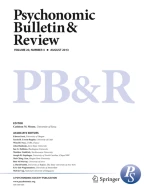Abstract
We report a new phenomenon associated with language comprehension: theaction—sentence compatibility effect (ACE). Participants judged whether sentences were sensible by making a response that required moving toward or away from their bodies. When a sentence implied action in one direction (e.g., “Close the drawer” implies action away from the body), the participants had difficulty making a sensibility judgment requiring a response in the opposite direction. The ACE was demonstrated for three sentences types: imperative sentences, sentences describing the transfer of concrete objects, and sentences describing the transfer of abstract entities, such as “Liz told you the story.” These data are inconsistent with theories of language comprehension in which meaning is represented as a set of relations among nodes. Instead, the data support an embodied theory of meaning that relates the meaning of sentences to human action.
Article PDF
Avoid common mistakes on your manuscript.
References
Barsalou, L. W. (1999). Perceptual symbols systems.Behavioral & Brain Sciences,22, 577–660.
Burgess, C., &Lund, K. (1997). Modelling parsing constraints with high-dimensional context space.Language & Cognitive Processes,12, 177–210.
Chomsky, N. (1980).Rules and representations. New York: Columbia University Press.
Fillmore, C. J., Kay, P., &O'Connor, M. C. (1988). Regularity and idiomaticity in grammatical constructions: The case of let alone.Language,64, 501–538.
Fincher-Kiefer, R. (2001). Perceptual components of situation models.Memory & Cognition,29, 336–343.
Fodor, J. (2000).The mind doesn't work that way. Cambridge, MA: MIT Press.
Gibson, J. J. (1979).The ecological approach to visual perception. Boston: Houghton Mifflin.
Glenberg, A. M. (1997). What memory is for.Behavioral & Brain Sciences,20, 1–55.
Glenberg, A. M., &Robertson, D. A. (1999). Indexical understanding of instructions.Discourse Processes,28, 1–26.
Glenberg, A. M., &Robertson, D. A. (2000). Symbol grounding and meaning: A comparison of high-dimensional and embodied theories of meaning.Journal of Memory & Language,43, 379–401.
Goldberg, A. E. (1995).A construction grammar approach to argument structure. Chicago: University of Chicago Press.
Harnad, S. (1990). The symbol grounding problem.Physica D,42, 335–346.
Kaschak, M. P., &Glenberg, A. M. (2000). Constructing meaning: The role of affordances and grammatical constructions in sentence comprehension.Journal of Memory & Language,43, 508–529.
Kay, P., &Fillmore,C. J. (1999).Grammatical constructions and linguistic generalizations: TheWhat's X doing Y? construction.Language,75, 1–33.
Keenan, J. M., Baillet, S. D., &Brown, P. (1984). The effects of causal cohesion on comprehension and memory.Journal of Verbal Learning & Verbal Behavior,23, 115–126.
Kintsch, W. (1988). The role of knowledge in discourse comprehension: A construction-integration model.Psychological Review,95, 163–182.
Lakoff, G. (1987).Women, fire, and dangerous things: What categories reveal about the mind. Chicago: University of Chicago Press.
McNeill, D. (1992).Hand and mind. Chicago: University of Chicago Press.
Meltzoff, A. N., &Moore, M. K. (1997). Explaining facial imitation: A theoretical model.Early Development & Parenting,6, 179–192.
Michaelis, L., &Lambrecht, K. (1996). Toward a construction-based model of language function: The case of nominal extraposition.Language,72, 215–247.
Novick, L. R., & Cheng, P. W. (in press). Assessing interactive causal influence.Psychological Review.
Ochs, E., Gonzales, P., &Jacoby, S. (1996). “When I come down I'm in the domain state”: Grammar and graphic representation in the interpretive activity of physicists. In E. Ochs, E. A. Schegloff, & S. A. Thompson (Eds.),Interaction and grammar (pp. 328–369). New York: Cambridge University Press.
O'Regan, J. K., &Noe, A. (2001). A sensorimotor account of vision and visual consciousness.Behavioral & Brain Sciences,24, 939–1031.
Piaget, J. (1954).The construction of reality in the child. New York: Basic Books.
Pinker, S. (1994).The language instinct. New York: HarperCollins.
Roth, W.-M. (1999). Discourse and agency in school science laboratories.Discourse Processes,28, 27–60.
Searle, J. R. (1980). Minds, brains and programs.Behavioral & Brain Sciences,3, 417–424.
Singer, M. (1994). Discourse inference processes. In M. A. Gernsbacher (Ed.),Handbook of psycholinguistics (pp. 479–517). San Diego: Academic Press.
Stanfield, R. A., &Zwaan, R. A. (2001). The effect of implied orientation derived from verbal context on picture recognition.Psychological Science,12, 153–156.
Talmy, L. (1988). Force dynamics in language and cognition.Cognitive Science,12, 49–100.
Tomasello, M. (2000). Do young children have adult syntactic competence?Cognition,74, 209–253.
Tucker, M., &Ellis, R. (1998). On the relations between seen objects and components of potential actions.Journal of Experimental Psychology: Human Perception & Performance,24, 830–846.
Van Den Broek, P. (1994). Comprehension and memory of narrative texts: Inferences and coherence. In M. A. Gernsbacher (Ed.),Handbook of psycholinguistics (pp. 539–589). San Diego: Academic Press.
Author information
Authors and Affiliations
Corresponding author
Additional information
This work was partially supported by a University of Wisconsin Vilas Associate Award to the first author and a National Science Foundation Graduate Fellowship to the second author.
Rights and permissions
About this article
Cite this article
Glenberg, A.M., Kaschak, M.P. Grounding language in action. Psychonomic Bulletin & Review 9, 558–565 (2002). https://doi.org/10.3758/BF03196313
Received:
Accepted:
Issue Date:
DOI: https://doi.org/10.3758/BF03196313
